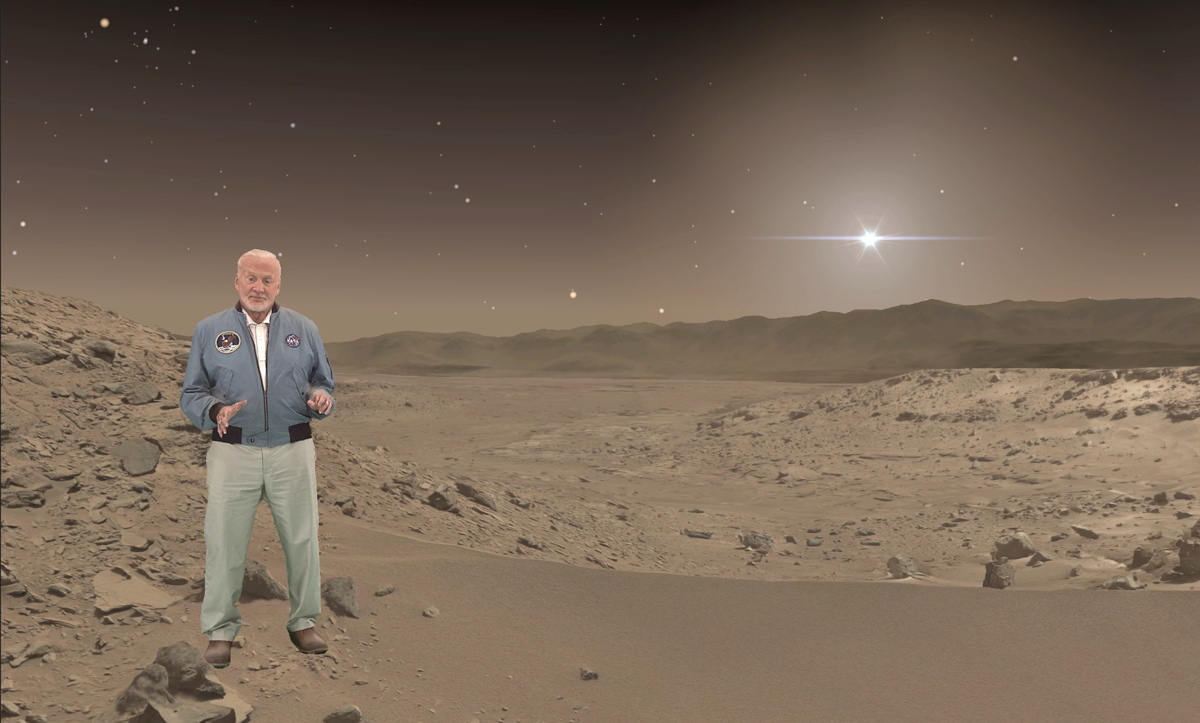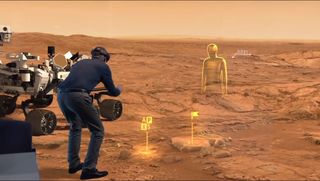'Destination: Mars': NASA Readies Virtual Red Planet Treks (with 'Buzz Aldrin'!)

Microsoft's virtual reality headset, the HoloLens, isn't yet commercially available, but the amazing new tech is coming to the Kennedy Space Center this summer, and offering visitors a "mixed-reality" tour of Mars.
NASA has announced that the Kennedy Space Center (KSC) Visitor Complex in Florida will host a new exhibit called "Destination: Mars" that will let visitors walk around on the Martian surface without ever leaving Earth. For the "mixed-reality" experience, visitors will don the HoloLens headset that shows realistic, 3D views of the Red Planet's surface. To make the experience more realistic, visitors will wear the goggles while walking around in a physical space, to further create the illusion they are on Mars.
The Red Planet tour is led by Apollo 11 moonwalker Buzz Aldrin — or at least, a hologram of Aldrin. Visitors will also be guided across the Martian surface by Erisa Hines (also in hologram form), who is a driver for the Mars Curiosity rover at NASA's Jet Propulsion Laboratory. [Amazing Views of Mars from NASA's Curiosity Rover]
"We're excited to give the public a chance to see Mars using cutting-edge technologies that help scientists plan Curiosity's activities on Mars today," Jeff Norris, project manager for "Destination: Mars," said in a the statement from the agency. "While freely exploring the terrain, participants learn about processes that have shaped this alien world."
Exploring the Martian surface via virtual reality is something NASA scientists already do with some regularity, according to a statement from the agency. "Destination: Mars" is adapted from a pilot program called OnSight (for which Norris is the program manager), which lets scientists "walk" on Mars, and get a sense of which formations or areas the Mars Curiosity Rover should explore next.
"OnSight makes the whole process of analyzing the data feel a lot more natural to me," Abigail Fraeman, a science team member for NASA Mars Curiosity Rover, said in the statement. "It really gives me the sense that I'm in the field when I put it on. Thinking about Martian geology is a lot more intuitive when I can stand in the scene and walk around the way I would if I were in the field."

Fraeman and a colleague used OnSight to "identify the transition point between two Martian rock formations, which they would like to study in further detail," the statement said.
Get the Space.com Newsletter
Breaking space news, the latest updates on rocket launches, skywatching events and more!
The new exhibit at KSC uses Microsoft's HoloLens, which have only just been released to app developers (they currently cost $3,000), and are not yet on sale to the public. The high price tag will apparently buy a cutting-edge VR experience. Microsoft's pilot app for the HoloLens is called Galaxy Explorer (it was chosen by popular vote), which will apparently let users explore the Milky Way. The company has been documenting the app's development in a Web series. When the goggles finally hit the market, users will be able to take a virtual tour of the galaxy from home.
Follow Calla Cofield @callacofield. Follow us @Spacedotcom, Facebook and Google+. Original article on Space.com.
Join our Space Forums to keep talking space on the latest missions, night sky and more! And if you have a news tip, correction or comment, let us know at: community@space.com.

Calla Cofield joined Space.com's crew in October 2014. She enjoys writing about black holes, exploding stars, ripples in space-time, science in comic books, and all the mysteries of the cosmos. Prior to joining Space.com Calla worked as a freelance writer, with her work appearing in APS News, Symmetry magazine, Scientific American, Nature News, Physics World, and others. From 2010 to 2014 she was a producer for The Physics Central Podcast. Previously, Calla worked at the American Museum of Natural History in New York City (hands down the best office building ever) and SLAC National Accelerator Laboratory in California. Calla studied physics at the University of Massachusetts, Amherst and is originally from Sandy, Utah. In 2018, Calla left Space.com to join NASA's Jet Propulsion Laboratory media team where she oversees astronomy, physics, exoplanets and the Cold Atom Lab mission. She has been underground at three of the largest particle accelerators in the world and would really like to know what the heck dark matter is. Contact Calla via: E-Mail – Twitter